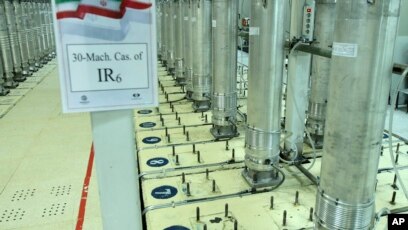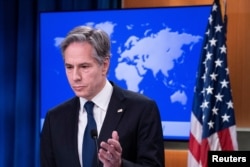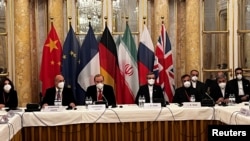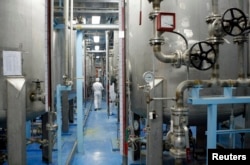
As Iran Nears Uranium Breakout Capacity, US Mulls Bomb-Making Scenarios
WASHINGTON —
With the United States warning that Iran is just weeks from developing the capacity to make a nuclear weapon, there is disagreement among Washington experts on the likelihood of Iran rushing to build such a weapon, and how the U.S. and its allies should deal with that risk.
“[Iran] is getting to the point where its breakout time, the time it would take to produce fissile material for a bomb, is getting down to a matter of a few weeks,” said U.S. Secretary of State Antony Blinken at a virtual event Monday.

The U.S. and Iran have been negotiating indirectly since last April to see if they can secure a mutual return to compliance with a 2015 deal in which Tehran promised to curb nuclear activities that could be weaponized in return for sanctions relief from the U.S. and other world powers.
“I think that will be decided in the next few weeks, because again, given what Iran is doing, we can’t allow this to go on,” Blinken said.
Iran says its nuclear activities are for civilian use and denies seeking nuclear weapons.
The U.S. left the 2015 deal, known as the Joint Comprehensive Plan of Action, or JCPOA, in 2018 when then-President Donald Trump said it was not tough enough on Tehran and unilaterally reimposed U.S. sanctions. Iran retaliated a year later by starting a process of increasingly exceeding JCPOA limits on its nuclear work.
The U.S and Iran decided to start indirect talks in Vienna last year, through the mediation of world powers, after President Joe Biden succeeded Trump and pledged to rejoin the JCPOA if Iran would return to limiting its nuclear activities under the deal.

The agreement was intended to prevent Iran from producing enough highly enriched uranium to make one nuclear bomb. The International Atomic Energy Agency says 25 kilograms of the uranium-235 isotope, which is accumulated when about 28 kilograms of uranium is enriched to 90% purity, is the breakout quantity at which the “possibility of manufacturing a nuclear explosive device cannot be excluded.”
Israel long has viewed a nuclear-armed Iran as an existential threat because of repeated calls by the Islamic Republic for the destruction of the Jewish state. Israeli officials have estimated it would take Iran two years after attaining a breakout capacity to develop, if it wanted, a nuclear-armed missile that could reach Israel.
U.S. physicist David Albright, president of the Institute for Science and International Security, told VOA Persian in a recent interview that Iran also could develop a cruder nuclear weapon in a much shorter time once it achieves a breakout capacity.
Georgetown University international relations professor Matthew Kroenig, who previously served as a U.S. Defense Department adviser on nuclear deterrence policy, told VOA that Iran could use that time to build a “gun-type” nuclear bomb.
“This is such a simple bomb design that the United States didn’t even test it before dropping one on Hiroshima in 1945,” Kroenig said.
Kroenig said Iran could deploy such a weapon by dropping it from a plane, driving it to a target in a truck, or putting it in a container on a ship that sails into a port. “There is a lot of mayhem that Iran could cause before it gets to a fully deliverable warhead on a ballistic missile,” he said.
Other analysts interviewed by VOA said there is little point in speculating about weaponization steps Iran could take post-breakout, because it does not appear to have made a decision to reach the breakout stage, let alone go beyond it.
Israeli military intelligence chief Major-General Tamir Hayman told Israeli news site Walla in October that Iran was “not heading toward a bomb right now.” Similarly, U.S. CIA chief William Burns told a Wall Street Journal forum on December 6 that he did not “see any evidence that Iran’s Supreme Leader has made a decision to move to weaponize,” according to CBS News.
Ploughshares Fund President Emma Belcher, whose grant-making organization seeks to prevent the spread of nuclear weapons, said ongoing IAEA inspections of Iran’s declared nuclear sites and Iranian leaders’ own statements also indicate a lack of intent to weaponize. “So, I am not concerned right now that Iran is going to do that,” she said.
Daryl Kimball, executive director of advocacy group Arms Control Association, said Iran also would see little benefit in making a crude nuclear bomb to use for blackmail or as a terrorist weapon against another country.
“Iran is a state with territory to defend and is concerned with regime preservation,” Kimball said. “Why would it, at great cost, give its terrorist proxies a nuclear device? The world would know where the fissile material came from. There are radiological fingerprints. So, there’s no escaping the attribution problem,” he added.
Even if Iran were to produce a breakout quantity of fissile material, Belcher said the U.S. and its allies could use diplomacy to try to secure Tehran’s agreement not to make it into a bomb.
“You could have a deal for Iran to down-blend that material so that it is no longer highly enriched, or you could ship that material elsewhere so that Iran cannot use it to create a nuclear weapon,” Belcher said.
Kimball said the international community also could use economic pressure, military strikes or covert action to make it difficult for a post-breakout Iran to build a nuclear bomb. He said if Iran tried to weaponize fissile material in secret by ejecting IAEA inspectors, further sabotage against Iranian nuclear sites would be “very likely.”

Scott Roecker, deputy vice president of the Nuclear Threat Initiative organization that advocates for reducing nuclear threats to humanity, said Iran has shown an increased desire in recent weeks to reach a deal to revive the JCPOA. But if that does not happen, he said continued diplomacy still would be the best way for the U.S. and its allies to deal with an Iran that has enough fissile material for one nuclear bomb.
“I don’t think there needs to be any drastic steps in the next few weeks, should Iran get to that point, because it still would have to take more steps to achieve a true nuclear weapon capability,” Roecker said.
But hoping that a post-breakout Iran will decide not to weaponize, and assuming that countermeasures will work in case it does, is a strategy that could backfire on the U.S., warned Kroenig and Albright.
“Once Iran gets the first bomb’s worth of weapons-grade uranium, we could try to negotiate with it for a year or two. But why would Iran invest billions of dollars and endure sanctions and threats of military strikes to get one screwdriver turn away from a nuclear weapon, and then voluntarily stop short in a negotiation?” Kroenig asked. “If Iran has a clear path to the nuclear-armed club, it eventually will build an arsenal like North Korea and Pakistan did.”
If Iran were to build a crude nuclear bomb and use it without claiming responsibility, Kroenig said nuclear forensic scientists would look at the explosion and try to determine what triggered it, but the process could take months and lead to several countries being identified as possible culprits. “In this scenario, it’s not obvious that the U.S. would take decisive action, given the uncertainty of where the bomb came from and the risk of escalation if Iran retaliates with another nuclear explosion,” he said.
Albright said a post-breakout Iran also could detonate a crude nuclear device underground within months in a symbolic test of its capabilities. He said such a test likely would heighten regional tensions and lead to nuclear proliferation, with Iran’s Gulf Arab rivals wanting to start nuclear weapon programs.
“These scenarios create more urgency for us to put up firebreaks so that Iran doesn’t cross the nuclear breakout
No comments:
Post a Comment